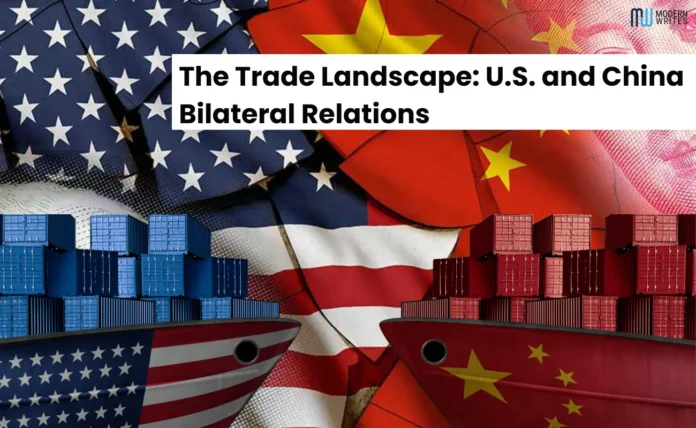The United States finds such a relationship to be crucial for the smooth operation of the international financial system, and it holds particular interest in this matter. The rise or fall in trade transactions from these countries has a serious effect on the market dynamics of international trade since they are the largest economies in the world.
The complex interactions determine the economic reality of the world, regardless of country borders. This is the reason behind the tough interaction between US and China Imports and Exports business. Lack of form to address potential issues and limited familiarity with these trading dynamics could lead to a unfortunate blunder. U.S. and China Bilateral Relations
The interactions between the industries, firms, and families of the two countries distribute the multiplier effect on a global level. These and other dynamics, such as tariffs and trade barriers, reshaping of supply chains, and geopolitical situations, are what reshape the market. To achieve stability and long term growth globally together we must pay attention to the details and make plans that would help us to be able to manage the global economy smartly. U.S. and China Bilateral Relations
The Trade Landscape: U.S. and China Bilateral Relations
Important businesses transits for both sides are the focal point of the US-China Import and Export, showcasing the economic interdependence of these two powers. A diverse array of manufacturing industries in China, spanning from textiles to high tech, are responsible for producing the Chinese goods, thereby satisfying the requirements of consumers and industries in China and importing countries.
To illustrate, the US comes out with commodities and services of various types. The standard commodities include leading airplanes, complex machinery, and seasonal fruits. Such bilateral transactions, which are instruments of stability in global trade, simultaneously boost productivity of the local businesses in both states. Longstanding disputes have been ever present in the relations, however, and they have contained the fights concerning trade barriers, intellectual property rights, and trade deficits.
As such, to sustain balanced interests that protect and promote continual growth even in the era of volatile geopolitics and economic volatility, countering such roadblocks would require acute diplomatic solutions and prudent strategic adjustments.
Trade War Ripples: Impact of Tariffs and Trade Barriers
In the past few years, the United States and China have entered into a trade war that is suddenly more visible in the placement of tariffs imposing billions dollars’ worth of goods. Eventually, these trade wars led to the intensification of relations at the level of governments. Industries, supply chains, and consumers and businesses alike suffered detrimental implications as funds were distracted to support trade hurdles during the manifestation of trade wars. U.S. and China Bilateral Relations
The importation ensuing higher key material and finished product prices led to business having a cold foot on new investment decisions, which negatively affected various supply chains internationally. The trade war between these two bohemian economies has made a wholesale impact, evident in the fact that consumer confidence has been going down with consumers concerned about soaring prices and dire consequences of the war on the world economy. U.S. and China Bilateral Relations
Reshaping Supply Chains: Shifts in Manufacturing and Sourcing U.S. and China Bilateral Relations
During the trade war, the businesses had no other choice but to revise their general plans of operation. Backing to reduce the tariff as well as geopolitical issues, the companies supposedly are considering of diversifying their production locations from China to others where it is safer, and they can operate comfortably. As a result of lower labour costs and their pro trade agreements, the countries located in the South-East Asia and South Asia regions have made a name for themselves as alternative production hubs.
Navigating Economic Realities: Impact on Consumers and Businesses
Apart from mere economic actions, this war also had an impact on people’s daily life and its effects weren’t simple. Consumers have seen the domestic prices on the imported goods, which include not only gadgets but also staples for the home, raise. This has created a problem for the household budgets as it demands to find more money to finish the already low budget.
On one hand, businesses combined the challenges of rising production costs, which only aggravated with disruptions in the supply chain and doubt on the likely trade policy to be in the future. Because of the first mentioned issues, companies had to review the way of doing business and face the additional expenses , that also delivered to the cutting of punitiveness. U.S. and China Bilateral Relations
At the end, the consequences of the trade war stand out for the audience that it never existed as an outline, theoretical or heavenly concept but a concrete, real-life scenario experienced by different people. This illustrated the fact that diplomacy was important to fixing the issue and to maintain trade serenity that is not only a source of economic welfare but also a guarantee of agreeable growth in the society. U.S. and China Bilateral Relations
The COVID-19 Pandemic: Disruptions and Resilience
Mainly due to the outbreak of the novel coronavirus and the epidemic of COVID-19, the trade structure of China and the US saw it more complex. All of these factors played their roles to make such shifts in the trade flows. The imports into many large economies including such as US, the EU, India and China facing with sharp reduction during the epidemic. Despite these hardships both countries, argued superbly and smoothly usual to the new life. U.S. and China Bilateral Relations
Such difficulties led to new opportunities when some firms cooperated, especially in producing medical, and tech goods. This case not only showed capability of one another in helping, it also showed the potential to achieve this in against threats across all the world. Despite the fact that both countries were in the economic wake of the pandemic at these times, their volume of finding common ground during that trouble was like a seeing light in the distance of future ties with them. U.S. and China Bilateral Relations
Looking Ahead: Prospects for Trade Cooperation and Challenges
While the world economy gets out of the throwback that was caused by the pandemic, US and China Imports and Exports may normalize their trade giving each side equal chance. Building of hope that the new management in the USA is more interested in a co-operative talk rather than execution of its unilateral decisions is rising. However, the existence of many conflicts remains a reality, including organic issues that are still pending, namely the protection of rational property as well as the entry into markets.
The critical issues have so to be tackled by us if the commercial relation which shall exist between us is to assist us both in earning as well as bearing each other’s burdens. It is required to conduct objective negotiations and propose effective decisions in order to create proper base and perspective for more secure and wealthy trade partnership at the end. There lies a reason why immigrant find it difficult to leave their country because the country is now a source of problems too. U.S. and China Bilateral Relations
Beyond Bilateralism: Implications for the Global Economy
The topic becomes more significant for the world economy as US and China Imports and Exports is dynamic and complex due to the fact it is highly interrelated. Trade policy changes, along the lines of being strong or helpful, tend to have effect in all the parts of the world. U.S. and China Bilateral Relations
This, in turn, affects trade at all levels, ranging from global economies to individual trade, users, and employees, regardless of the lands they are on. Due to this fact, it is of great importance to try to spark positive discussions and create some common ground among the trade concerns in order to sustain the stability and thrive in the connected global economy. U.S. and China Bilateral Relations
Conclusion U.S. and China Bilateral Relations
Policy makers may recognize it that the trade relationship between the United States of America and China is to some extent controlled by the geopolitics vision, the economic rationalities and global stresses. A total understanding of the varied issues is a requirement to solve problems successfully and to be willing to provide in negotiations, argument, etc.
However, the future of global trade does not only depend on the doubts; there are also a myriad of chances for partnership and mutual gain too, which will have great proposal of the mind-set of the country in the years to come. U.S. and China Bilateral Relations




